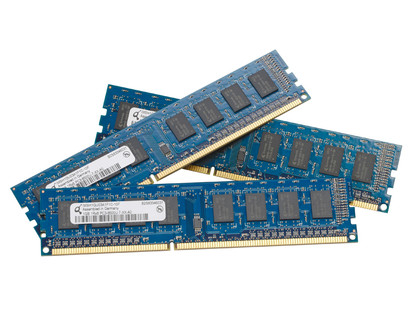Next-gen storage that makes SSD look slow
Speedy alternatives to the humble hard drive
Main memory speed is what we are really after, so why not use a drive composed of full-fat RAM in the first place? The idea dates back to the late 1970s, when discs were floppy, made grinding noises and were achingly slow.
These days you can get drives that plug straight into your SATA controller and are fitted with DRAM modules and a battery. You'll need the battery because otherwise everything evaporates when you switch off; a fundamental problem.
These things are fast, though - fast enough to virtually swamp your SATA interface, murdering all the competition; they can shift gigabytes per second and random access time is in the 0.0-something range. So, its quick.

The first snag is felt in the wallet. RAM is expensive and you'll want a ton of it. Even the biggest modules are small in the world of storage. Fill eight slots with 2GB modules and that's a painful £200 minimum, before you've bought your RAM drive (£200 and up). After all that you've still only got a 16GB drive, barely enough for Windows and a couple of friends; hardly an HDD replacement so once again we are running two drives.
Another major snagette is that to keep the data you need constant power, either an external supply, a small battery pack or some other storage to back it up (some flash RAM works well).
RAM takes a fair amount of power to keep fresh, a battery of twice the oomph of a mobile phone gives about 16 hours. If you've installed Windows then an external power pack is best. The data risk loss is unacceptable for a single drive system and limits RAM drives to the specialist role. Still, speed is alluring isn't it?
A RAM drive is currently the canine orbs of performance, hundreds of times faster than the best mechanical devices. Whack Windows on it and or use it as a scratch disc for Photoshop or other such drive intensive jobs and you get a nice bang for your (not inconsiderable) buck.
Get daily insight, inspiration and deals in your inbox
Sign up for breaking news, reviews, opinion, top tech deals, and more.
A RAM drive is a better bet than shelling out an extra couple of hundred to get the next best processor up the ladder and well worth considering if a fast PC is your bag (if it isn't you might be reading the wrong mag).
Ideal world
The latest fastest spinning HDDs remain attractive, they may get hot, consume lots of power, make a fair bit of noise, but they can shift really big blocks of data effectively and a terabyte is a terabyte after all.
Running an SSD, instead, is great for machines that aren't expected to store a ton of data, (fiddly little notebooks), and they make an excellent partner for a fat HDD in desktop. If you feel adventurous and slightly rich then adding a DDR RAM drive gives you the ultimate in performance.
We want the capacities and prices of traditional hard drives, the non-volatile nature of SSD and the pure speed of main memory RAM. Well, you can't have that, yet. But there are plenty of people toiling away to bring it to you.
There are a good dozen new memory technologies in the wings - MRAM, CBRAM, PRAM, NRAM, SONOS, TRAM, FeRAM and many more. Some use a matrix of magnets to store bits, others use ions within an electrolyte, phase changing materials or various applications of nanotechnology. The dream of some is a universal memory – a single big block of RAM replacing all storage and your main memory.
This one is a way-away yet, but we can certainly expect SSDs to start developing very quickly now and there's a lot of technology filtering down from the server market to come. Desktop drives are turning solid state. And this is a good thing.
- 1
- 2
Current page: Using RAM drives for ultimate performance
Prev Page Your hard drive is the bottleneck